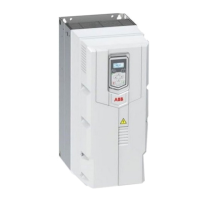Program features 81
Brake chopper
A brake chopper can be used to handle the energy generated by a decelerating
motor. When the DC voltage rises high enough, the chopper connects the DC circuit
to an external brake resistor. The chopper operation is based on hysteresis.
The internal brake choppers in the drive (in frames R0…R3) start conducting at
internal brake chopper start limit 780 V and stop conducting at internal brake chopper
stop limit 760 V (AC supply 380…480 V).
For information on external brake choppers, refer to the respective user manual.
Note: Overvoltage control needs to be disabled for the chopper to operate.
Settings
Parameter 01.11 DC voltage (page 165), 30.30 Overvoltage control (page 256) and
parameter group 43 Brake chopper (page 312).
Safety and protections
Fixed/Standard protections
Overcurrent
If the output current exceeds the internal overcurrent limit, the IGBTs are shut down
immediately to protect the drive.
DC overvoltage
See section Overvoltage control on page 77.
DC undervoltage
See section Undervoltage control (power loss ride-through) on page 77.
Drive temperature
If the temperature rises high enough, the drive first starts to limit the switching
frequency and then the current to protect itself. If it is still keeps heating up, for
example because of a fan failure, an overtemperature fault is generated.
Short circuit
In case of a short circuit, the IGBTs are shut down immediately to protect the drive.
Emergency stop
The emergency stop signal is connected to the input selected by parameter 21.05
Emergency stop source. An emergency stop can also be generated through fieldbus
(parameter 06.01 Main control word, bits 0…2).

